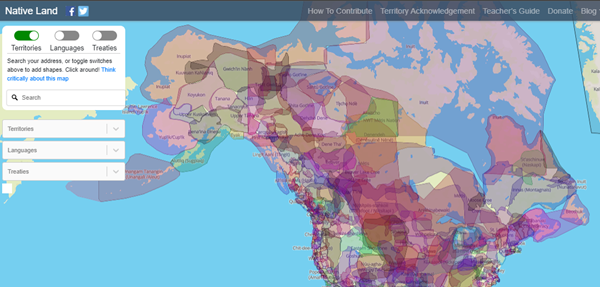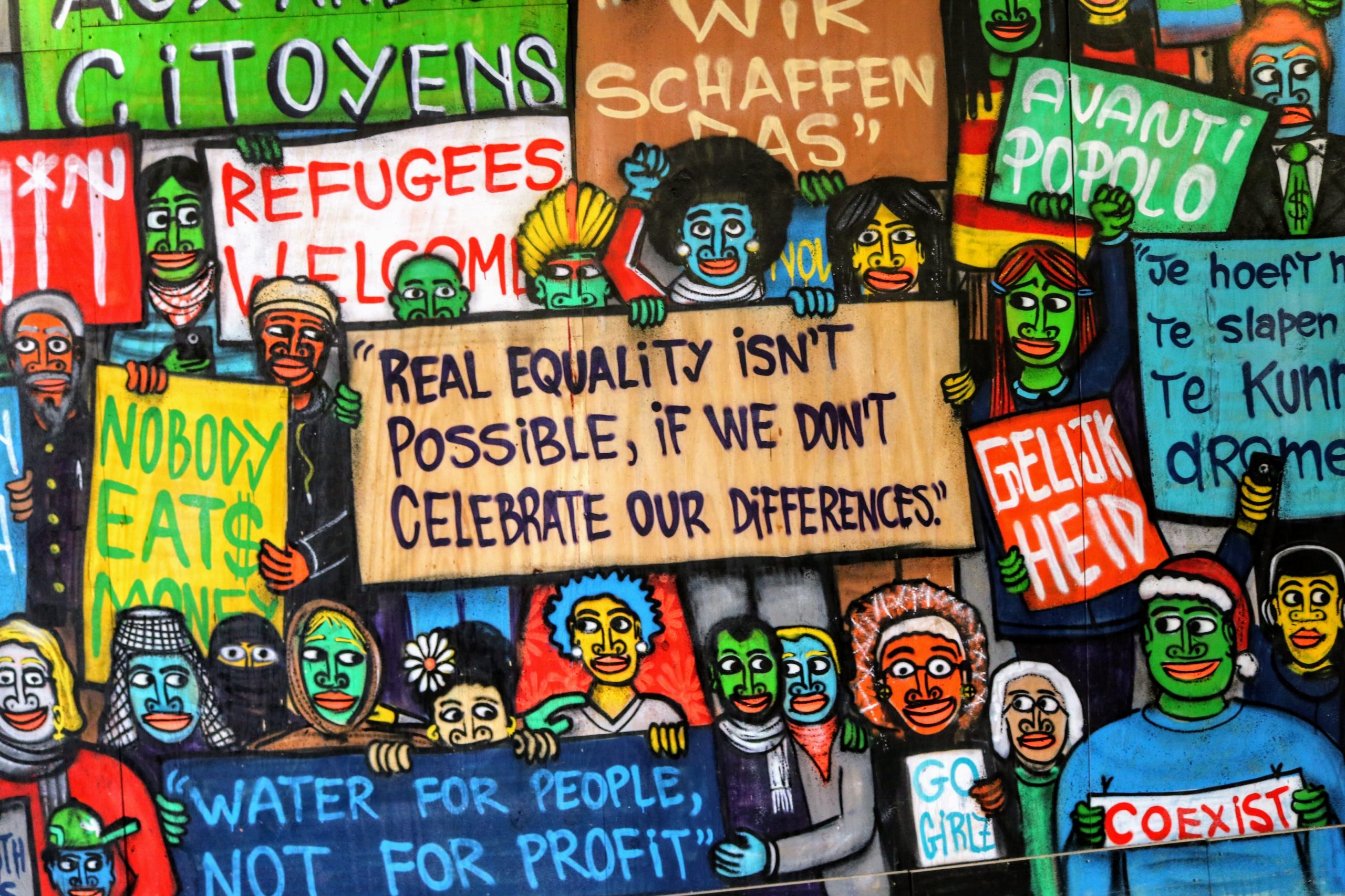10 Things Successful Students Do
3 Successful students embrace a diverse community
Successful students use their college experience to meet new people and gain understanding of others’ viewpoints. Sometimes, we can have preformed ideas about people who are different than we are and may feel more comfortable with people who are “like” us. However, by starting with being open to getting to know people as individuals, we can break down many barriers and misconceptions. This can help you become a better global citizen as well as better understand the values of multiculturalism that we hold dear in Canadian society. Multiculturalism involves an attitude of respect for the feelings, ideas, behaviors, and experiences of others who differ from oneself in any way.
Learning about different people can help us learn more about ourselves as often our own culture is invisible to us. We may have ideas about what is customary behavior and we may have negative reactions when someone does something different. To prevent or resolve conflicts that may occur in any social interaction, you should maintain an attitude of respect for others, be open minded and willing to compromise, and know how to work together calmly to resolve conflicts.

As you begin to explore how you are different than others in a respectful way, you begin to understand why you think and behave in certain ways based on your upbringing and past experiences and appreciate that this does not have to be the only way to approach life. Experiencing new ways of thinking, ideas, concepts and values leads to deeper and more complex thinking and creativity. Diversity on campus is beneficial for all students, not just those from ethnic or minority groups. The wider perspectives of students from different backgrounds and the greater variety of teaching methods help everyone gain more fully in educational experiences. Socially, students develop a more mature worldview and are better prepared for interacting with a diverse world in the future. Students who embrace opportunities to experience diversity have greater satisfaction with their college careers and take a personal responsibility both for broadening their own social world and for speaking out against prejudice and discrimination wherever encountered.
Let’s talk Land Acknowledgements
St. Clair College Traditional Land Acknowledgment
St. Clair College would like to recognize and acknowledge that it sits on the Three Fires Confederacy’s traditional territory of the Ojibwe, Odawa, and Potawatomi nations. We would also like to acknowledge the many other tribes and indigenous nations that call this beautiful land home. We give thanks to the land and surrounding Water for sustaining us.
This acknowledgment is part of how we, at St. Clair College, recognize that we are guests on these lands and that Indigenous peoples were here long before St. Clair College, Chatham, Windsor, Ontario or even Canada existed.
Take a look at the image below. It probably does not look like the map of Canada you may have seen before. That is because it does not show provinces, but rather it shows territories of Indigenous peoples.

This image was taken from Native-Land.ca, a not-for-profit organization that is attempting to map the traditional territories, languages and treaties of Indigenous peoples as a way for non-indigenous people to explore the land they live on.
Victor Temprano (2017), initial creator of Native-Land.ca, wrote “I wanted to make something to reach out to non-Indigenous people (like myself), something that would engage them in with Indigenous history in a friendly and interesting way. Indigenous people already know their territory — it’s the ‘settlers’ who needed to have a look at the information I was collecting. I wanted people to have Indigenous names and lands in mind as they went about their days.” Feel free to explore Native-Land.ca in more depth.
Refer to the accordion below for more information:
What Diversity Really Means
Ours is a very diverse society and increasingly so. But diversity means much more than a variety of racial and ethnic differences. As we’ll use the term here, diversity refers to the great variety of human characteristics, ways that we are different even as we are all human and share more similarities than differences. These differences are an essential part of what enriches humanity.
We’ll look first at some of the ways that people differ and explore the benefits of diversity for our society generally and for the college experience. While we should all celebrate diversity, at the same time we need to acknowledge past issues that grew from misunderstandings of such differences and work together to bring change where needed.

Differences among people may involve where a person was born and raised, the person’s family and cultural group, factual differences in personal identity, and chosen differences in significant beliefs. Some diversity is primarily cultural, other diversity may be biological, and some diversity is defined in personal terms. Diversity generally involves things that may significantly affect some people’s perceptions of others, not just any way people happen to be different.
When discussing diversity, it is often difficult to avoid seeming to generalize about different types of people and such generalizations can seem similar to dangerous stereotypes. The following descriptions are meant only to suggest that individuals are different from other individuals in many possible ways and that we can all learn things from people whose ideas, beliefs, attitudes, values, backgrounds, experiences, and behaviors are different from our own. This is a primary reason college admissions departments frequently seek diversity in the student body.
Types of Diversity
When discussing diversity, it is often difficult to avoid seeming to generalize about different types of people and such generalizations can seem similar to dangerous stereotypes. The following descriptions are meant only to suggest that individuals are different from other individuals in many possible ways and that we can all learn things from people whose ideas, beliefs, attitudes, values, backgrounds, experiences, and behaviours are different from our own. This is a primary reason college admissions departments frequently seek diversity in the student body.

What can students do?
While diversity exists in most places, not everyone automatically understands differences among people and celebrates the value of those differences. Students who never think about diversity and who make no conscious effort to experience and understand others gain less than others who do. There are many ways you can experience the benefits of diversity on our college campus, however, beginning with your own attitudes and by taking steps to increase your experiences with diverse individuals.
Acknowledge your own uniqueness, for you are diverse, too. Diversity doesn’t involve just other people. Consider that you may be just as different to other people as they are to you. Don’t think of the other person as being the one who is different, that you are somehow the “norm.” Your religion may seem just as odd to them as theirs does to you, and your clothing may seem just as strange looking to them as theirs is to you—until you accept there is no one “normal” or right way to be. Look at yourself in a mirror and consider why you look as you do. Why do you use the slang you do with your friends? Why did you just have that type of food for breakfast? How is it that you prefer certain types of music? Read certain books? Talk about certain things? Much of this has to do with your cultural background—so it makes sense that someone from another cultural or ethnic background is different in some ways. But both of you are also individuals with your own tastes, preferences, ideas, and attitudes—making you unique. It’s only when you realize your own uniqueness that you can begin to understand and respect the uniqueness of others, too.
Consider your own (possibly unconscious) stereotypes. A stereotype is a fixed, simplistic view of what people in a certain group are like. It is often the basis for prejudice and discrimination: behaving differently toward someone because you stereotype them in some way. Stereotypes are generally learned and emerge in the dominant culture’s attitudes toward those from outside that dominant group. A stereotype may be explicitly racist and destructive, and it may also be a simplistic generalization applied to any group of people, even if intended to be flattering rather than negative. As you have read this module so far, did you find yourself thinking about any group of people, based on any kind of difference, and perhaps thinking in terms of stereotypes? If you walked into a party and saw many different kinds of people standing about, would you naturally avoid some and move toward others? Remember, we learn stereotypes from our cultural background—so it’s not a terrible thing to admit you have inherited some stereotypes. Thinking about them is a first step in breaking out of these irrational thought patterns.
Diversity Thought Activity
Challenge your thinking: Part 1
Challenge your thinking: Part 2

Now think for a minute about how you responded in these scenarios.
- Did your mental image in the first scenario involve a negative stereotype? What images in the media or society might have contributed to that response?
- The second and third scenarios involve simple situations in which you couldn’t help but note some difference between you and another person. What might you feel in such situations in real life?
- Again, there is no “right” answer, and an awareness of differences is normal and natural even if it may cause some discomfort at first. On the other hand, if you have had significant experiences with diverse others, you might have read these scenarios and simply wondered, “So what? What’s the big deal?” It’s worthwhile thinking about what that means.
Don’t try to ignore differences among people. Some people try so hard to avoid stereotyping that they go to the other extreme and try to avoid seeing any differences at all among people. But as we have seen throughout this module, people are different in many ways, and we should accept that if we are to experience the benefits of diversity.
Don’t apply any group generalizations to individuals. As an extension of not stereotyping any group, also don’t think of any individual person in terms of group characteristics. People are individuals first, members of a group second, and any given generalization simply may not apply to an individual. Be open minded and treat everyone with respect as an individual with their own ideas, attitudes, and preferences.
Develop cultural sensitivity for communication. Realize that your words may not mean quite the same thing in different cultural contexts or to individuals from different backgrounds. This is particularly true of slang words, which you should generally avoid until you are sure the other person will know what you mean. Never try to use slang or expressions you think are common in the cultural group of the person you are speaking with. Similarly, since body language often varies among different cultures, avoid strong gestures and expressions until the responses of the other person signify he or she will not misinterpret the messages sent by your body language.
Take advantage of campus opportunities to increase your cultural awareness. There are multiculturalism special events, cultural fairs and celebrations, concerts, and other programs held frequently on campus.
The Benefits of Diversity
The goal of many college admissions departments is to attract diverse students from a broad range of backgrounds involving different cultural, socioeconomic, age, and other factors—everything in the preceding list. But why is diversity so important?

There are many reasons:
* Experiencing diversity at college prepares students for the diversity they will encounter the rest of their lives. Learning to understand and accept people different from ourselves is very important in our world.
* Students learn better in a diverse educational setting. Encountering new concepts, values, and behaviors leads to thinking in deeper, more complex, and more creative ways, rather than furthering past ideas and attitudes.
* Experiencing diversity on campus is beneficial for all students. Students have more fulfilling social relationships and report more satisfaction and involvement with their college experience.
* Diversity experiences help break the patterns of segregation and prejudice that have characterized North American history. Discrimination against others, whether by race, gender, age, sexual orientation, or anything else, is rooted in ignorance and sometimes fear of people who are different. Getting to know people who are different is the first step in accepting those differences, furthering the goal of a society free of all forms of prejudice and the unfair treatment of people.
* Students of a traditional college age (early 20’s) are in an ideal stage of development for forming healthy attitudes about diversity. The college years are a time of growth and maturation intellectually, socially, and emotionally, and a sustained experience of diversity is an opportunity to heighten this process.
* Experiencing diversity makes us all better citizens in our democracy. When people can better understand and consider the ideas and perspectives of others, they are better equipped to participate meaningfully in our society.
* Diversity enhances self-awareness. We gain insights into our own thought processes, life experiences, and values as we learn from people whose backgrounds and experiences are different from our own.
A word about multiculturalism
More than anything, multiculturalism is an attitude. Multiculturalism involves accepting and respecting the ideas, feelings, behaviors, and experiences of people different from oneself—all the forms of diversity described earlier. Canada is not actually a “melting pot” in the sense that people from diverse backgrounds somehow all become the same. Canada has always included a great diversity of ideas, attitudes, and behaviors. People of diverse religious backgrounds are not expected to “melt” together into one religion. Canada’s Charter of Rights and Freedoms guarantees the equal rights of all people regardless of skin color, gender, age, and other differences—including, equality under the law for those with diverse sexual orientation.
A number of years ago, a Danish television station created a commercial titled “All that we share” to demonstrate the diversity of the Danish people. It has a powerful but simple message: we have more in common then we realize.
The Importance of Community
St. Clair College is a vibrant and diverse community of students, staff, faculty and administrators. As a community, St. Clair has a culture all it’s own. In this video, Irene Stewart continues her workshop called College, the St. Clair Way. Let’s listen in for a perspective on what values are important at St. Clair College both in and out of the classroom.
Getting Along With Others
Interdependence
Humans are social creatures—it’s simply in our nature. We continually interact with other students and professors, and we can learn a great deal from these interactions that heighten the learning process. This frequent interaction with others forms a state of interdependence. College students depend on their professors, but just as importantly, they depend on other students in many ways.
As important as our interactions with others are, we do not automatically possess the skills that help us form good relationships and make the most of our experiences.
Consider how these two college students are different:

John often arrives just as class is beginning and leaves immediately afterward. He makes little effort to talk with other students in the classroom, and after class he goes off to study alone or to his part-time job, where he spends most of his time at a computer screen. He is diligent in his studies and generally does well. After two months, he has not gotten to know his roommate very well, and he generally eats alone with a book in hand. He stops by to see his professors in their offices only if he missed a class due to illness, and on weekends and holidays he often hangs out at his parents’ house or sees old friends.

Kim likes to get to class early and sits near others so they can talk about the reading for class or compare notes about assignments. She enjoys running into other students she knows from her classes and usually stops to chat. Although she is an older working student who lives alone off campus, she often dines in a campus café and asks students she meets in her classes to join her. After two months, with the approach of midterms, she formed a study group with a couple other students. If she feels she doesn’t understand an important lecture topic very well, she gets to her professor’s office a few minutes ahead of office hours to avoid missing out by having to wait in line. A few weeks into the term, she spent a weekend with a student from another country and learned much about a culture about which she had previously known little.
These students are very different. Which do you think is more fully enjoying the college experience? Which do you think is more likely to do well academically? Most of us fall somewhere between these two extremes, but we can learn to be more like Kim and more actively engage with others.
Recognize the Value of Social Interaction
Building good relationships is important for happiness and a successful college experience. College offers the opportunity to meet many people you would likely not meet otherwise in life.
Make the most of this opportunity to gain a number of benefits:
- A growing understanding of diverse other people, how they think, and what they feel that will serve you well throughout your life and in your future career
- A heightened sense of your own identity, especially as you interact with others with different personalities and from different backgrounds
- Emotional comfort from friendship with someone who understands you and with whom you can talk about your problems, joys, hopes, and fears
- An opportunity to grow with wider intellectual and emotional horizons, college often offers an opportunity to be stimulated and excited by new relationships and interactions with people who will challenge your thinking and help you become your best. Still, it can be difficult to get started with new relationships in college.
Making New Friends

Some people just make friends naturally, but many first-year college students are more shy or quiet and may need to actively seek new friends. Here are some starting points:
- Keep all doors open for meeting new people. Try to sit with different people at meals so you can get to know them better. Study in a common area or lounge where you’ll be among others.
- Be open in your interests. Don’t limit yourself to people who share only certain interests. Meeting people by studying together is an excellent way to get to know people with different interests.
- Don’t try to get involved in everything going on around you. Committing to too many activities or joining too many social groups will spread your time too thin, and you may not spend enough time with anyone to get to know them.
- Let others see who you really are. Let people get to know the things you’re interested in, your real passions. People who really know you are more likely to become good friends.
- Make an effort to get to know others, too. Show some interest. Don’t talk just about your interests—ask them about theirs. Show others that you’re interested, that you think they’re worth spending time with, and that you really do want to get to know them.
- Once a friendship has started, be a good friend. Respect your friends for what they are and don’t criticize them or talk about them behind their back. Give emotional support when your friends need it and accept their support as well when you need it.
Are You Shy?
If you’re shy, try meeting and talking to people in situations where you can interact one-to-one, such as talking with another student after class. Start with what you have in common— “How’d you do on the test?” —and let the conversation grow from there. Avoid the emotional trap of thinking everyone but you is making new friends and start some conversations with others who look interesting to you. You’ll soon find other “shy” or quiet people eager to interact with you as well and get to know you. Shy people may be more likely to feel lonely at times, especially while still feeling new at college. Loneliness is usually a temporary emotional state, however.
Managing Conflict
Conflicts among people who are interacting are natural. People have many differences in opinions, ideas, emotions, and behaviors, and these differences sometimes cause conflicts. So how can such conflicts be resolved?
Two things are necessary for conflict resolution that does not leave one or more of the people involved feeling negative about the outcome: attitude and communication.
A conflict cannot be resolved satisfactorily unless all people involved have the right attitude:

- Respect the opinions and behaviors of others. Accept that people are not all alike and learn to celebrate your differences. Most situations do not involve a single right or wrong answer.
- Be open minded. Just because at first you are sure that that you are right, do not close the door to other possibilities. Look at the other’s point of view. Be open to change—even when that means accepting constructive criticism.
- Calm down. You can’t work together to resolve a conflict while you’re still feeling strong emotions. Agree with the other to wait until you’re both able to discuss it without strong emotions.
- Recognize the value of compromise. Even if you disagree after calmly talking over an issue, accept that as a human reality and understand that a compromise may be necessary in order to get along with others.
With the right attitude, you can then work together to resolve the issue. This process depends on good communication:
- Listen. Don’t simply argue for your position, but listen carefully to what the other says. Pay attention to their body language as you try to understand their point of view and ask questions to ensure that you do. Paraphrase what you think you hear to give the other a chance to correct any misunderstanding.
- Use “I statements” rather than “you statements.” Explain your point of view about the situation in a way that does not put the other person on the defensive and evoke emotions that make resolution more difficult. Don’t blame the other for the problem, that would just get emotions flowing again.
In most cases, when the people involved have a good attitude and are open to compromise, conflicts can be resolved successfully.
Yet sometimes there seems to be no resolution. Sometimes the other person may simply be difficult and refuse to even try to work out a solution. Regrettably, not everyone on or off campus is mature enough to be open to other perspectives.
With some interpersonal conflicts, you may simply have to decide not to see that person anymore or find other ways to avoid the conflict in the future. But remember, most conflicts can be solved among adults, and it’s seldom a good solution to run away from a problem that will continue to surface and keep you from being happy with your life.
Steps to follow
In any friendship or relationship, conflict will eventually happen. This is just natural because people are different. If a conflict is ignored, or the partners just argue without resolving it, it may simmer and continue to cause tension, eventually weakening the relationship. It’s better to take steps to resolve it. Conflict resolution is a process of understanding what’s really going on and then finding a solution. The same general steps of conflict resolution can work to solve a relationship conflict or a conflict between any people or groups because of a disagreement about anything. Following are the general principles of conflict resolution:
- Allow things to cool off. It’s difficult to resolve a conflict while either party is still emotional. Wait a few minutes or agree to talk about it later.
- Using “I statements” rather than “you statements,” each party explains what bothers him or her about the cause of the conflict. “You statements” put the other person on the defensive and evoke emotions that make resolution more difficult.
- Listen carefully to what the other person says. Then restate the message in your own words to give the other a chance to clarify their thoughts and feelings. Each party should listen to the other and restate the other’s message to ensure the real issue is out on the table for discussion.
- Accept responsibility for your role in the conflict, instead of blaming the other.
- Brainstorm together to find a solution that satisfies both of you. Some compromise is usually needed, but that is usually not difficult to reach when you’re calm and are working together on a solution.
- Apologize, thank, and forgive. After reaching a resolution, emotional closure is needed to restore your relationship and end on a positive, affirming note. When appropriate, apologize for your past anger or arguing. Thank the other for being willing to compromise to resolve the conflict. In your mind, forgive the person for past misunderstandings and actions so that you do not carry any grudge into the future.
Let’s rejoin Irene Stewart’s presentation to hear about the value of conflict resolution in our community.
Dealing With Harassment
Although college campuses are for the most part safe, secure, and friendly places where social and intellectual interaction is generally mature and responsible, harassment can occur in any setting. Harassment is a general term referring to behavior that is intended to disturb or threaten another person in some way, often psychologically. Typically the person or people doing the harassment target their victim because of a difference in race, ethnicity, religion, nationality, sex, age, sexual orientation, or disability.

Acts of harassment may be verbal, physical, psychological, or any other behavior intended to disturb another person.
Bullying behavior, name-calling, belittling, gesturing obscenely, stalking, mobbing—any action intended to torment or deliberately make another person uncomfortable or feel humiliated is harassment. Harassment may also be intended to manipulate a targeted person to act in some specific way. Sexual harassment is a special term referring to persistent, unwanted sexual behaviors or advances.
Harassment of any type, at any time, of any person, is wrong and unacceptable. You will know it if you are harassed, and you should know also that it is your basic right to be free of harassment and that all colleges lay out strict policies against all forms of harassment.
Here’s what you should do if you are being harassed:
- Tell the person to stop the behavior or if you feel at any risk of harm, get out of the situation immediately.
- Document the incident, particularly with ongoing harassment. Keep notes of the details. Tell someone you trust about the situation.
- Report the harassment to the appropriate college authority. If you are unsure which to go to, go to the Campus Hearing Officer.
Take a Stand against Prejudice and Hate
Unfortunately prejudice and hate still exist in Canada, even on college campuses. In addition to racial prejudice, some people are also prejudiced against women, people with disabilities, older adults, gays and lesbians — virtually all groups that can be characterized as “different.” But it is not enough for only college administrators to fight prejudice and hate — this is a responsibility for all good citizens who take seriously the shared Canadian value of equality for all people.
So what can you as a college student do?

Decide that it does matter. Prejudice threatens us all, not just the particular group being discriminated against in a specific incident. Don’t stand on the sidelines or think it’s up to the people who may be victimized by prejudice or hate to do something about it. We can all do something.
Talk with others. Communication has great value on campuses. Let others know how you feel about any acts of prejudice or hatred that you witness. The more everyone openly condemns such behavior, the less likely it is to reappear in the future. This applies even if you hear another student telling a racist joke or putting down the opposite sex—speak up and tell the person you find such statements offensive. You don’t want that person to think you agree with them. Speaking up can be difficult to do, but it can be done tactfully.
Be a good citizen. People can and do learn what is acceptable in a diverse environment. Report incidents you observe. If you happen to see someone spray-painting a hateful slogan, for example, be a good citizen and report it to the campus security or the police.
Support student groups working for change. Canada has a great tradition of college students banding together to help solve social problems. Show your support for groups and activities that celebrate diversity and condemn prejudice. Even if you are a shy, quiet person, your attendance at a parade or gathering lends support. Once you become aware of such student activities on campus, you’ll find many ways you can help take a stand.
Celebrate diversity. In many ways, you can learn more about diversity through campus programs and activities. The more all students participate, the closer the campus will come to being free of prejudice and hate.
Be a role model in how you act and what you say in relation to diversity, and you may have more effect on others than you realize.
Key Takeaways
- Successful students use their college experience to meet new people and gain an understanding of others’ viewpoints.
- Learning about different people helps you learn more about yourself and appreciate your own culture.
- Embracing diversity on campus is beneficial for all students, leading to more fulfilling social relationships and better educational experiences.
- Understanding the value of social interaction and building good relationships regardless of background can lead to greater self-awareness and a richer social life.
- Harassment is unacceptable and should be reported immediately to the appropriate college authority.
- Take a stand against prejudice and hate by speaking up, supporting student groups, celebrating diversity, and being a role model.

Want more? The Learning Portal’s Maamwi Hub has excellent resources to help explore Indigenous history, culture and worldviews.

